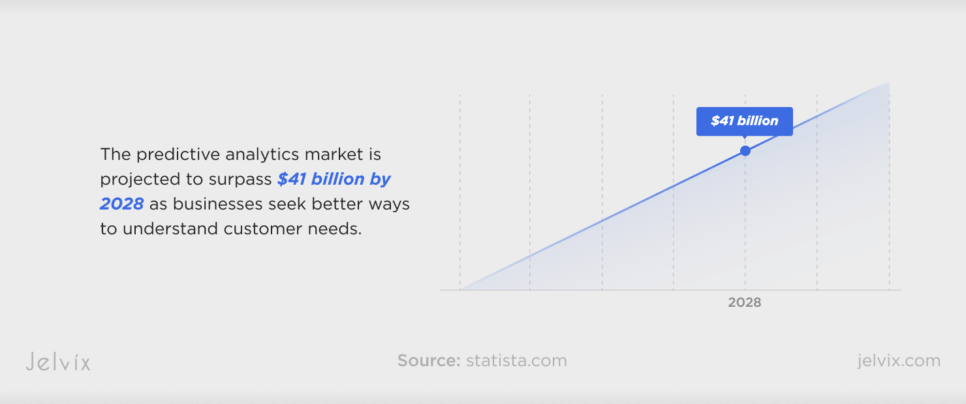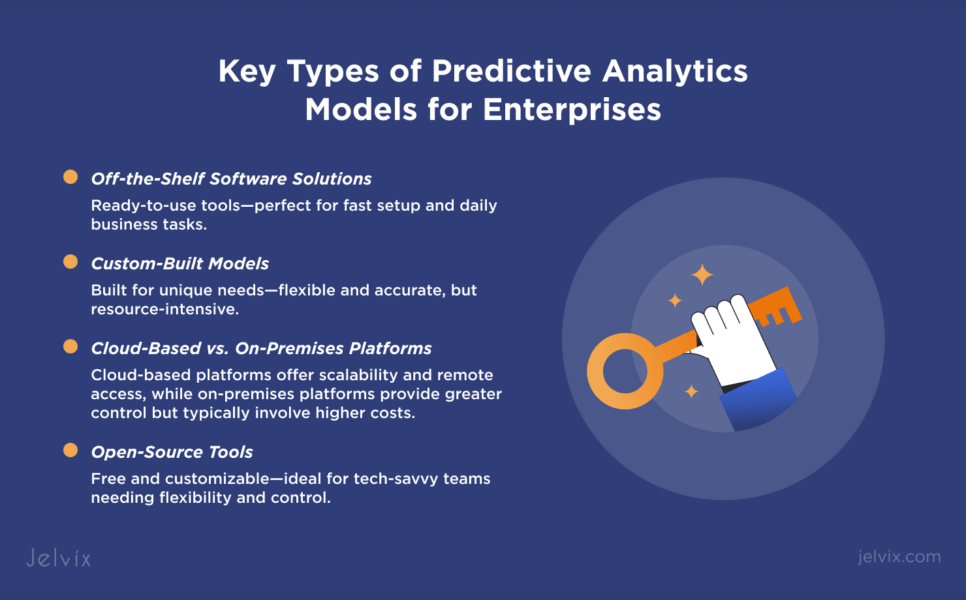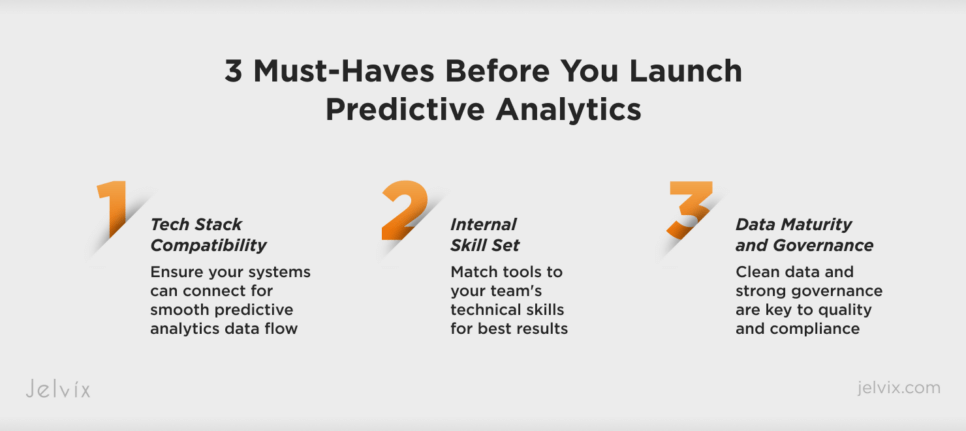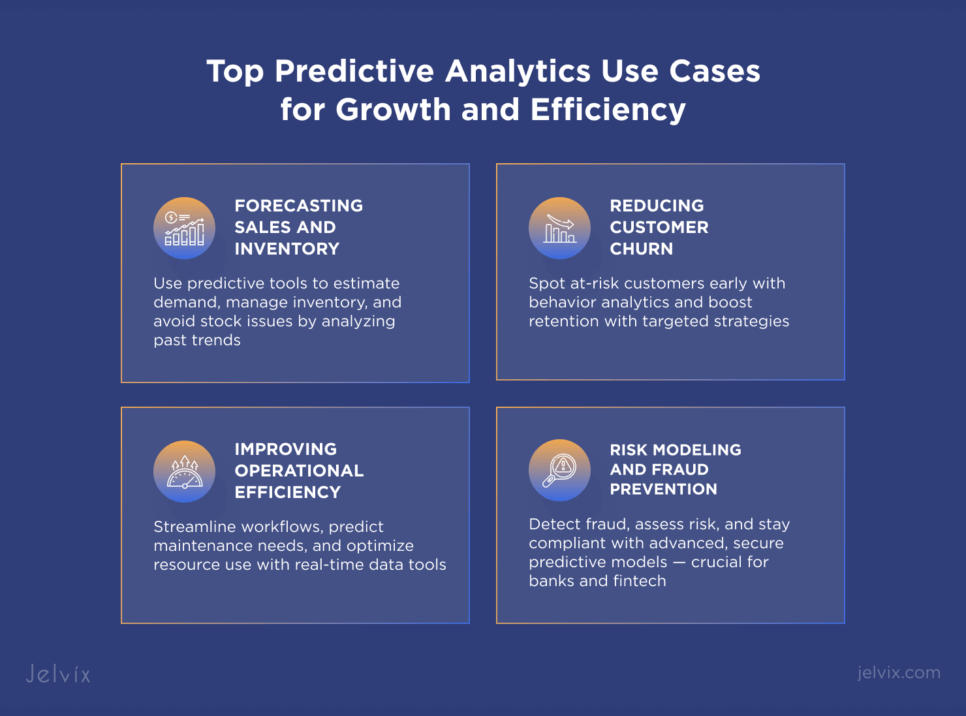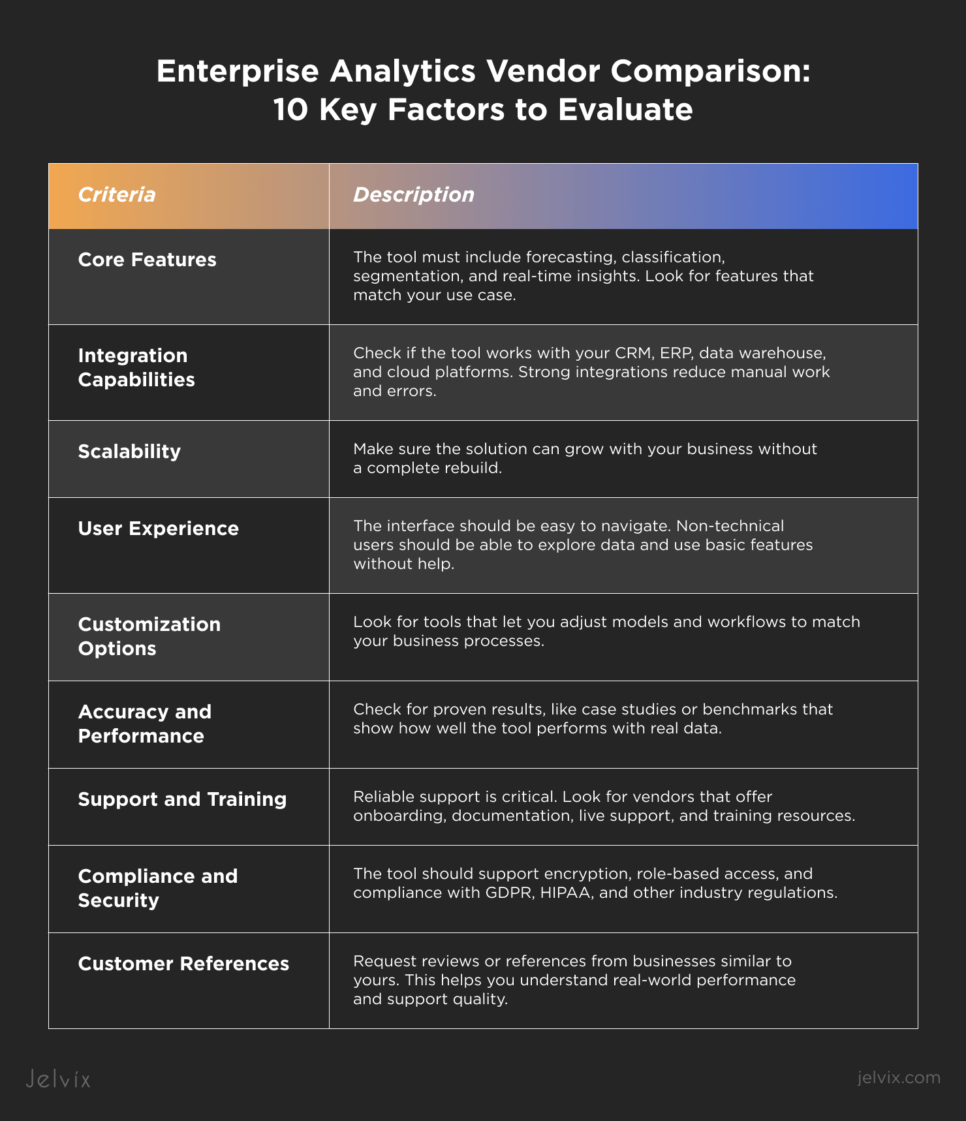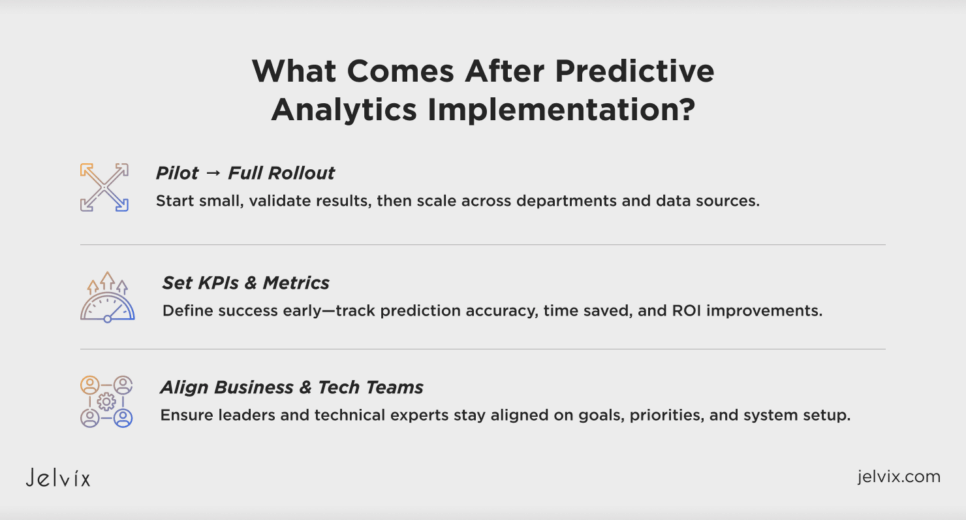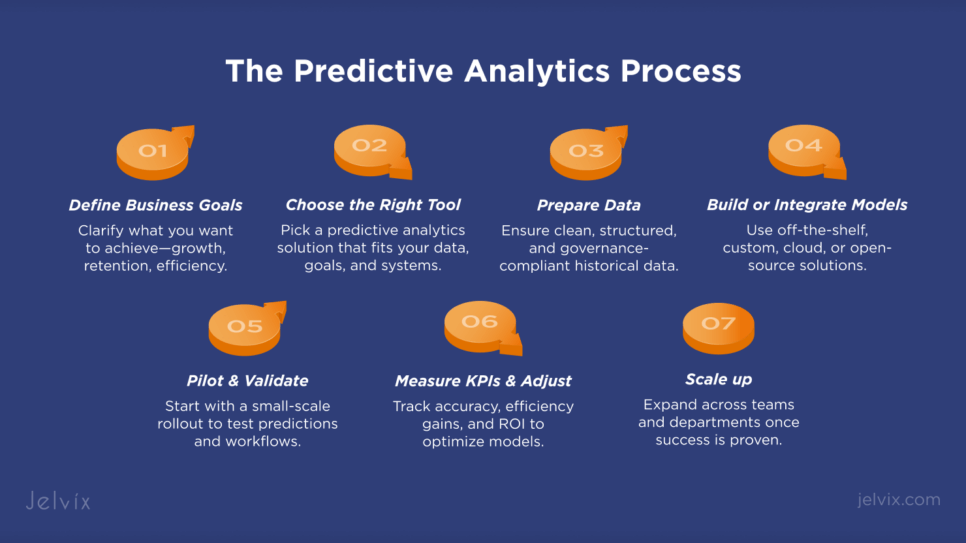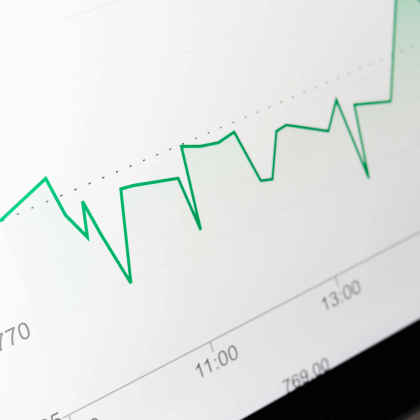As customer demands grow, businesses need better ways to understand what people want. Many opt for using predictive analytics software, with its market expected to surpass USD 41 billion by 2028.
The variety of big data predictive analytics solutions allows companies to choose the right one for their objectives. However, the downside here is that selecting the wrong tool can lead to missed growth opportunities and a waste of budget.
If you want to adopt AI predictive analytics that will help you analyze consumer behavior and manage business operations, read this article. You’ll learn more about key types of predictive analytics tools, what to look for when choosing one, and how to check if your company is ready to get started.
How To Spot the Best Predictive Analytics Software for Your Needs
To find the right predictive analytics tool, start by thinking about your business needs and what you want to achieve, like forecasting sales or improving customer retention. Make sure the tool fits your data types and is easy enough for your team to use. It should also work well with your current systems and stay within your budget. Focus on practical value, not just advanced features.
Common Pitfalls Businesses Face When Choosing Predictive Analytics Tools
Many businesses run into problems when choosing enterprise data analytics solutions. The right way to prevent possible issues is to be aware of what can go wrong.
Choosing Based on Popularity
A widely used and popular tool might not solve your specific problems. Always focus on whether the tool fits your business needs, not just its brand reputation.
Overlooking Usability
If a tool is too complex, your team may avoid using it. Make sure the platform is user-friendly and offers training or tutorials for your workers.
Underestimating Scalability
Some tools work well for small projects, but struggle to operate as your data grows. Choose a flexible solution that can support your processes and workflows over time.
Ignoring Customer Support
Strong support can make a big difference, especially when issues arise or when your team needs help getting started. Check if the provider offers good documentation, live support, or training resources.
Rushing the Decision
Jumping into a long-term contract without testing the tool can lead to regret and budget loss. Try to start with a demo or short-term trial to make sure the solution really works for you.
Key Types of Predictive Analytics Models That Can Fit Your Enterprise
You can choose from several types of real-time predictive analytics software, and each one works best in different situations.
Off-the-Shelf Software Solutions
These are ready-made tools that come with built-in features and models. They’re easy to set up and suitable for everyday business needs like sales forecasts or churn prediction. It’s best for teams that want quick results without deep technical skills.
Custom-Built Models
These solutions are built from scratch to solve specific problems for your enterprise. They offer better flexibility and accuracy but require data scientists and more development time. They can be a good fit for companies with unique or complex needs.
Cloud-Based vs On-Premises Platforms
Cloud data analytics tools run online and don’t need a local installation. They’re easy to scale and access from anywhere. On-premises platforms run on your corporate servers, giving more control and security, but often cost more and require in-house IT support.
Open-Source Tools and Their Applicability
Open-source tools like Python libraries (e.g., scikit-learn, TensorFlow) are free and highly customizable. They’re great for tech-savvy teams but require coding knowledge and setup time. They work best for companies with skilled data teams looking for flexibility and control.
Read more about how to choose between custom and off-the-shelf EHR solutions based on your business goals, budget, and long-term scalability needs.
Implementing Predictive Analytics: A Short Business Readiness Checklist
Before you dive into predictive analytics, make sure your enterprise is ready for changes. Business analysts from Jelvix developed a checklist to help you evaluate your company’s readiness.
Tech Stack Compatibility
Your current software and systems must be able to connect with the predictive analytics tool. This includes CRM systems, databases, cloud storage, and data visualization tools. Without this connection, it will be harder to move data efficiently and get helpful insights.
Data Maturity and Governance
The business should have enough historical data that is clean, structured, and updated. A data governance process must be in place to ensure quality, consistency, and compliance with privacy rules. Predictive models rely on accurate data, so gaps or errors can lead to poor results.
Internal Skill Set
Businesses with in-house data scientists or analysts can take advantage of more advanced tools and build custom models. Teams without technical expertise will need user-friendly platforms that offer guided workflows, automation, and support. Knowing your team’s skill level helps avoid underused or overly complex tools.
Key Factors To Consider When Choosing Enterprise Data Analytics Solutions
Selecting the right predictive analytics solution means looking beyond features. The best tool should match your business needs today and grow with you over time.
Scalability and Flexibility
Your solution must be able to handle increasing amounts of data and more complex use cases as your business grows. Flexible tools allow you to adjust models, add new data sources, or expand to other departments without starting over.
Integration with Existing Systems
You’ll get no use even of the best solution if it doesn’t integrate well with CRMs, ERPs, data warehouses, and other systems. In contrast, flawless integration helps reduce setup time and allows for real-time data insights.
User-Friendliness and Accessibility
Tools should match your team’s skill level. A user-friendly interface makes it easier for business users to explore data and use predictive features without constant help from technical teams.
Cost Implications and ROI
The total cost includes licensing, setup, training, and maintenance. It’s important to balance upfront costs with long-term value. The best tools show clear returns, such as increased sales, reduced churn, or faster decision-making.
Vendor Support and Community Engagement
Reliable customer support is essential, especially during setup or when issues happen. A strong user community also adds value by offering shared knowledge, tutorials, and best practices.
Comparing Predictive Analytics Software by Business Type
Different businesses have different needs when it comes to predictive analytics. The size of the company, the industry, and future growth plans affect which solution works best.
Enterprises vs SMBs
The total volume of globally created and consumed data reached 149 zettabytes in 2024. As large enterprises keep creating more data, they need advanced tools that can handle these volumes, support custom models, and integrate across many departments. Such software also offers in-house data teams to manage complexity.
Scalable predictive analytics for mid-size companies and smaller entities includes user-friendly solutions with guided features. These tools are easier to implement and require less technical support.
Industry-Specific Needs
It’s critical to consider the special needs of your industry to choose the right tool.
If you operate in medical settings, note that the best predictive analytics tools for healthcare should support data accuracy, regulatory compliance, and strong privacy protections. They must be able to process sensitive data and provide explainable results.
Retail businesses benefit most from real-time analytics, demand forecasting, and customer behavior insights. Integration with point-of-sale and e-commerce systems is key here.
In 2024, the FTC reported about USD 12.5 billion in total losses related to financial fraud. That’s why the best predictive analytics tools for finance need to have robust fraud detection, powerful risk modeling, and strict data governance. Security and auditability are critical in this business area.
Finally, manufacturing focuses on predictive maintenance, supply chain optimization, and production forecasting, so analytical tools must handle equipment data and IoT inputs.
Scalability and Long-Term Flexibility
Businesses planning to grow or adapt over time need solutions that scale with them. This includes handling more data, users, and use cases without requiring a complete system change. Flexible platforms allow for customization and new integrations as business needs evolve.
Top Feature To Look for in Predictive Analytics Services and Solutions
Not all predictive analytics tools offer the same features. If you’re not sure what features to look for in predictive analytics software, look closely at what each solution includes and how it fits your business needs.
Key Integrations
The chosen tool should connect easily with your existing systems, such as ERPs, cloud platforms, and data lakes. Strong integration allows for seamless data flow and faster insights.
Real-Time Processing and Forecast Accuracy
Real-time processing enables quick reactions to changes in customer behavior, market trends, or operations. High forecast accuracy depends on the quality of your data and the strength of the models used. Tools should offer clear performance metrics so you can track prediction quality.
Customization vs Pre-Built Models
Pre-built models are faster to deploy and easier for non-technical users, while custom models allow deeper control and better alignment with specific business goals. The best tools offer a balance, giving you the option to start with templates and customize them as needed.
Security, Compliance, and Data Ownership
The best predictive analytics tools for finance, healthcare, or other heavily regulated industries must support security features like encryption and role-based access controls, comply with regulations like HIPAA or GDPR, and clearly define who owns the data.
Explore how blockchain technology can reshape your business security strategy and open new growth opportunities.
Enterprise Analytics Vendor Vetting Framework
Choosing the right vendor is just as important as choosing the right tool. A solid vetting process can help you avoid costly mistakes and find a partner that supports your long-term success.
During real-time predictive analytics software comparison, evaluate vendors based on 10 key factors.
Spotting Red Flags in Product Demos and Case Studies
Even promising vendors can raise concerns once you look more closely. During demos and while reviewing case studies, watch out for several warning signs.
Overly Generic Demos
Demos that feel too broad or too polished may not reflect you real use case. If the tool isn’t shown in a context that matches your industry or workflow, it may not be a good fit.
Lack of Real Performance Data
Trustworthy vendors back up their claims with data. If there are no metrics showing model accuracy or business impact, that’s a sign the results may not be reliable.
Outdated or Missing Case Studies
Vendors should be able to show recent examples of how their tool works in real-world settings. A lack of up-to-date case studies may indicate limited adoption or success.
Overpromising During Sales Pitches
Be cautious if the vendor makes bold claims like “instant results” or “zero setup.” These usually oversimplify the process and can set unrealistic expectations.
Unclear Pricing Models
Hidden fees or vague contract terms can drive up the cost over time. Transparent pricing, clear licensing, and flexible plans are vital to avoid surprises.
Matching Solutions to Business Goals: Predictive Analytics Examples and Use Cases
Different analytics tools work best for various goals. That’s why it can be a good idea to get familiar with predictive analytics use cases for business growth and successful implementation.
Forecasting Sales and Inventory
Retailers and manufacturers use predictive tools to estimate future demand and manage inventory levels. Off-the-shelf solutions with built-in forecasting models help prevent overstock and stockouts by analyzing past sales, seasonality, and market trends.
Reducing Customer Churn
Subscription-based businesses often rely on predictive models to spot which customers are at risk of leaving. Tools that focus on customer behavior patterns and engagement signals allow teams to act early with targeted retention strategies.
Improving Operational Efficiency
In industries like logistics, healthcare, and manufacturing, predictive analytics helps streamline workflows. For example, it can optimize delivery routes, predict equipment maintenance needs, or allocate resources more effectively. Solutions with real-time data processing are especially useful here.
Risk Modeling and Fraud Prevention
Banks, insurers, and fintech companies use predictive models to assess credit risk, detect fraud, and manage compliance. These tools often require advanced customization and strong data security features to meet regulatory standards and minimize financial losses.
Next Steps after Implementing Predictive Analytics in Your Business Workflows
Buying the tool is only the beginning. A successful rollout requires a clear plan, defined goals, and alignment across your team.
Roadmap from Pilot to Full-Scale Rollout
Start with a pilot project that’s small, focused, and easy to measure. Use it to test how the tool performs with your real data and team workflows. Once it proves value, scale up gradually, adding new use cases, departments, or data sources.
Setting KPIs and Success Metrics
Establish clear performance indicators from the start. This could include prediction accuracy, time saved, cost reductions, or conversion improvements. Tracking KPIs helps show business value and guides future enhancements.
Aligning Business and Technical Stakeholders
Business users and technical teams need to be on the same page. Business leaders should define goals and priorities, while technical teams choose the correct data and configure the system. Regular check-ins and shared documentation help keep everyone aligned.
How To Implement Predictive Analytics and Move Forward with Confidence?
Starting with predictive analytics takes planning, the right tools, and support from your team. It also requires comparing predictive analytics solutions for business needs and goals to ensure you move in the right direction.
As a seasoned tech partner, Jelvix helps companies bring predictive analytics to life by integrating a pre-made solution or building a custom one from scratch. With deep expertise in data, AI, and system integration, Jelvix experts make sure your analytics tool fits your goals and delivers value. Contact us to explore how predictive analytics can help your business grow, work smarter, and boost ROI.
Need more than just lines of code?
We build smart, tailored tech solutions that grow with your business.


